Rheological and Textural Properties of Apple Pectin-Based Composite Formula with Xanthan Gum Modification for Preparation of Thickened Matrices with Dysphagia-Friendly Potential
Abstract
1. Introduction
2. Materials and Methods
2.1. Materials and Reagents
2.2. Preparation of Model Food Matrices (MFDs)
2.3. Degree of Esterification (DE)
2.4. Rheological Measurements and Flow Behavior Characterization
2.5. Texture Profile Analysis (TPA)
2.6. Scanning Electron Microscopy (SEM)
2.7. Data Manipulation and Statistical Analysis
3. Results and Discussion
3.1. Degree of Esterification (DE)
3.2. Rheological Characterization
3.2.1. Rheological Features of AP at Various Concentrations
3.2.2. Time-Concentration Superposition of AP Hydrocolloids
3.2.3. Rheological Properties of XG at Various Concentrations
3.2.4. Effects of Basic Formulation Ingredients (BFIs) on AP and XG Hydrocolloids
3.2.5. Rheological Behavior of DFMs with a AP-XG Composite (Blend) Thickener
3.2.6. Flow Behavior Characterization
3.3. Texture Profile Analysis (TPA)
3.4. Scanning Electron Microscopic (SEM) Analysis
3.5. Justification of Application Limitations and Future Works
4. Conclusions
Author Contributions
Funding
Institutional Review Board Statement
Informed Consent Statement
Data Availability Statement
Acknowledgments
Conflicts of Interest
References
- Aslam, M.; Vaezi, M.F. Dysphagia in the elderly. Gastroenterol. Hepatol. 2013, 9, 784–795. [Google Scholar] [CrossRef]
- Newman, R.; Vilardell, N.; Clavé, P.; Speyer, R. Effect of bolus viscosity on the safety and efficacy of swallowing and the kinematics of the swallow response in patients with oropharyngeal dysphagia: White paper by the European society for swallowing disorders (ESSD). Dysphagia 2016, 3, 232–249. [Google Scholar] [CrossRef]
- Cichero, J.A.; Steele, C.; Duivestein, J.; Clavé, P.; Chen, J.; Kayashita, J.; Lam, P. The need for international terminology and definitions for texture-modified foods and thickened liquids used in dysphagia management: Foundations of a global initiative. Curr. Phys. Med. Rehabil. Rep. 2013, 1, 280–291. [Google Scholar] [CrossRef]
- Andersen, U.T.; Beck, A.M.; Kjaersgaard, A.; Hansen, T.; Poulsen, I. Systematic review and evidence based recommendations on texture modified foods and thickened fluids for adults (≥18 years) with oropharyngeal dysphagia. e-SPEN 2013, 8, e127–e134. [Google Scholar] [CrossRef]
- Vilardell, N.; Rofes, L.; Arreola, V.; Speyer, R.; Clavé, P. A comparative study between modified starch and xanthan gum thickeners in post-stroke oropharyngeal dysphagia. Dysphagia 2016, 31, 169–179. [Google Scholar] [CrossRef] [PubMed]
- Rofes, L.; Arreola, V.; Mukherjee, R.; Swanson, J.; Clavé, P. The effects of a xanthan gum-based thickener on the swallowing function of patients with dysphagia. Aliment. Pharmacol. Ther. 2014, 39, 1169–1179. [Google Scholar] [CrossRef]
- Matta, Z.; Chambers, E., IV; Garcia, J.M.; Helverson, J.M. Sensory characteristics of beverages prepared with commercial thickeners used for dysphagia diets. J. Am. Diet. Assoc. 2006, 106, 1049–1054. [Google Scholar] [CrossRef] [PubMed]
- Payne, C.; Methven, L.; Fairfield, C.; Gosney, M.; Bell, A.E. Variability of starch-based thickened drinks for patients with dysphagia in the hospital setting. J. Texture Stud. 2012, 43, 95–105. [Google Scholar] [CrossRef]
- Tombs, M.P.; Harding, S.E. An Introduction to Polysaccharide Biotechnology, 2nd ed.; Taylor and Francis: London, UK, 1998. [Google Scholar]
- Van Buren, J.P. Function of pectin in plant tissue structure and firmness. In The Chemistry and Technology of Pectin; Reginald, H.W., Ed.; Academic Press: New York, NY, USA, 1991; pp. 1–22. [Google Scholar]
- Thibault, J.F.; Ralet, M.C. Physico-chemical properties of pectins in the cell walls and after extraction. In Advances in Pectin and Pectinase Research; Voragen, A.G.J., Schols, F.H., Visser, R., Eds.; Kluwer Academic: Dordrecht, The Netherlands, 2003; pp. 91–105. [Google Scholar] [CrossRef]
- Mesbahi, G.; Jamalian, J.; Farahnaky, A. A comparative study on functional properties of beet and citrus pectins in food systems. Food Hydrocoll. 2005, 19, 731–738. [Google Scholar] [CrossRef]
- Gawkowska, D.; Cybulska, J.; Zdunek, A. Structure-related gelling of pectins and linking with other natural compounds: A review. Polymers 2018, 10, 762. [Google Scholar] [CrossRef]
- Löfgren, C.; Guillotin, S.; Hermansson, A.-M.J.B. Microstructure and kinetic rheological behavior of amidated and nonamidated LM pectin gels. Biomacromolecules 2006, 7, 114–121. [Google Scholar] [CrossRef]
- Naqash, F.; Masoodi, F.A.; Rather, S.A.; Wani, S.M.; Gani, A. Emerging concepts in the nutraceutical and functional properties of pectin—A review. Carbohydr. Polym. 2017, 168, 227–239. [Google Scholar] [CrossRef]
- Morales-Contreras, B.E.; Wicker, L.; Rosas-Flores, W.; Contreras-Esquivel, J.C.; Gallegos-Infante, J.A.; Reyes-Jaquez, D.; Morales-Castro, J. Apple pomace from variety “Blanca de Asturias” as sustainable source of pectin: Composition, rheological, and thermal properties. Lwt 2020, 117, 108641. [Google Scholar] [CrossRef]
- Ropartz, D.; Ralet, M.C. Pectin Structure. In Pectin: Technological and Physiological Properties, 1st ed.; Kontogiorgos, V., Ed.; Springer International Publishing: Cham, Switzerland, 2020; pp. 17–34. [Google Scholar] [CrossRef]
- Funami, T. Next target for food hydrocolloid studies: Texture design of foods using hydrocolloid technology. Food Hydrocoll. 2011, 25, 1904–1914. [Google Scholar] [CrossRef]
- Hyun, K.; Wilhelm, M.; Klein, C.O.; Cho, K.S.; Nam, J.G.; Ahn, K.H.; McKinley, G.H. A review of nonlinear oscillatory shear tests: Analysis and application of large amplitude oscillatory shear (LAOS). Prog. Polym. Sci. 2011, 36, 1697–1753. [Google Scholar] [CrossRef]
- Kar, F.; Arslan, N. Effect of temperature and concentration on viscosity of orange peel pectin solutions and intrinsic viscosity–molecular weight relationship. Carbohydr. Polym. 1999, 40, 277–284. [Google Scholar] [CrossRef]
- Antonic, B.; Jancikova, S.; Dordevic, D.; Tremlova, B. Apple pomace as food fortification ingredient: A systematic review and meta-analysis. J. Food Sci. 2020, 85, 2977–2985. [Google Scholar] [CrossRef]
- Yoon, S.N.; Yoo, B. Rheological behaviors of thickened infant formula prepared with xanthan gum-based food thickeners for dysphagic infants. Dysphagia 2017, 32, 454–462. [Google Scholar] [CrossRef] [PubMed]
- Yang, H.; Lin, Y. Effect of Thermal Processing on Flow Properties and Stability of Thickened Fluid Matrices Formulated by Tapioca Starch, Hydroxyl Distarch Phosphate (E-1442), and Xanthan Gum Associating Dysphagia-Friendly Potential. Polymers 2021, 13, 162. [Google Scholar] [CrossRef]
- Yang, H.-W.; Dai, H.-D.; Huang, W.-C.; Sombatngamwilai, T. Formulations of dysphagia-friendly food matrices with calorie dense starchy thickeners and their stability assessments. J. Food Meas. Charact. 2020, 14, 3089–3102. [Google Scholar] [CrossRef]
- Cichero, J.A. Evaluating chewing function: Expanding the dysphagia field using food oral processing and the IDDSI framework. J. Texture Stud. 2020, 51, 56–66. [Google Scholar] [CrossRef] [PubMed]
- Lara-Espinoza, C.; Carvajal-Millán, E.; Balandrán-Quintana, R.; López-Franco, Y.; Rascón-Chu, A. Pectin and Pectin-Based Composite Materials: Beyond Food Texture. Molecules 2018, 23, 942. [Google Scholar] [CrossRef] [PubMed]
- Gómez, B.C.A.; Gullón, B.; Remoroza, C.; Schols, H.A.; Parajó, J.C.; Alonso, J.L. Purification, characterization, and prebiotic properties of pectic oligosaccharides from orange peel wastes. J. Agric. Food Chem. 2014, 62, 9769–9782. [Google Scholar] [CrossRef] [PubMed]
- Gómez, B.C.A.; Gullón, B.; Yáñez, R.; Schols, H.; Alonso, J.L. Prebiotic potential of pectins and pectic oligosaccharides derived from lemon peel wastes and sugar beet pulp: A comparative evaluation. J. Funct. Foods 2016, 20, 108–121. [Google Scholar] [CrossRef]
- Chung, W.S.F.; Meijerink, M.; Zeuner, B.; Holck, J.; Louis, P.; Meyer, A.S.; Wells, J.M.; Flint, H.J.; Duncan, S.H. Prebiotic potential of pectin and pectic oligosaccharides to promote anti-Inflammatory commensal bacteria in the human colon. FEMS Microbiol. Ecol. 2017, 93, 1–9. [Google Scholar] [CrossRef] [PubMed]
- Wicker, L.; Kim, Y.; Kim, M.J.; Thirkield, B.; Lin, Z.; Jung, J. Pectin as a bioactive polysaccharide–extracting tailored Function from Less. Food Hydrocoll. 2014, 42, 251–259. [Google Scholar] [CrossRef]
- Makarova, E.; Górna’s, P.; Konrade, I.; Tirzite, D.; Cirule, H.; Gulbe, A.; Pugajeva, I.; Seglina, D.; Dambrova, M. Acute anti-hyperglycaemic effects of an unripe apple preparation containing phlorizin in healthy volunteers: A preliminary study. J. Sci. Food Agric. 2015, 95, 560–568. [Google Scholar] [CrossRef] [PubMed]
- Gunness, P.; Gidley, M.J. Mechanisms underlying the cholesterol-lowering properties of soluble dietary fibre polysaccharides. Food Funct. 2010, 1, 149–155. [Google Scholar] [CrossRef]
- Peng, X.-Y.; Mu, T.-H.; Zhang, M.; Sun, H.-N.; Chen, J.-W.; Yu, M. Effects of pH and high hydrostatic pressure on the structural and rheological properties of sugar beet pectin. Food Hydrocoll. 2016, 60, 161–169. [Google Scholar] [CrossRef]
- Elblbesy, M.A.; Hereba, A.T. Computation of the coefficients of the power law model for whole blood and their correlation with blood parameters. Appl. Phys. Res. 2016, 8, 1–9. [Google Scholar] [CrossRef]
- de Alcântara, M.G.; de Freitas Ortega, N.; Souza, C.J.F.; Garcia-Rojas, E.E. Electrostatic hydrogels formed by gelatin and carrageenan induced by acidification: Rheological and structural characterization. Food Struct. 2020, 24, 100137. [Google Scholar] [CrossRef]
- Rascón-Chu, A.; Díaz-Baca, J.A.; Carvajal-Millan, E.; Pérez-López, E.; Hotchkiss, A.T.; González-Ríos, H.; Balandrán-Quintana, R.; Campa-Mada, C. Electrosprayed core–shell composite microbeads based on pectin-arabinoxylans for insulin carrying: Aggregation and size dispersion control. Polymers 2018, 10, 108. [Google Scholar] [CrossRef] [PubMed]
- Morris, G.; Foster, T.; Harding, S.J.F.H. The effect of the degree of esterification on the hydrodynamic properties of citrus pectin. Food Hydrocoll. 2000, 14, 227–235. [Google Scholar] [CrossRef]
- Li, J.; Zhang, Y.; Fan, Q.; Teng, C.; Xie, W.; Shi, Y.; Yang, Y. Combination effects of NaOH and NaCl on the rheology and gel characteristics of hen egg white proteins. Food Chem. 2018, 250, 1–6. [Google Scholar] [CrossRef]
- Zhao, X.; Zhou, Y.; Liu, J.; Chen, J.; Ye, F.; Zhao, G. Effects of sucrose on the structure formation in high-methoxyl apple pectin systems without acidifier. Food Hydrocoll. 2020, 105, 105783. [Google Scholar] [CrossRef]
- Winter, H.H.; Chambon, F. Analysis of linear viscoelasticity of a crosslinking polymer at the gel point. J. Rheol. 1986, 30, 367–382. [Google Scholar] [CrossRef]
- National Dysphagia Diet Task Force. In National Dysphagia Diet: Standardization for Optimal Care; American Dietetic Association: Chicago, CA, USA, 2002.
- Zhang, C.; Zhu, X.; Zhang, F.; Yang, X.; Ni, L.; Zhang, W.; Liu, Z.; Zhang, Y. Improving viscosity and gelling properties of leaf pectin by comparing five pectin extraction methods using green tea leaf as a model material. Food Hydrocoll. 2020, 98, 105246. [Google Scholar] [CrossRef]
- Trappe, V.; Weitz, D.A. Scaling of the viscoelasticity of weakly attractive particles. Phys. Rev. Lett. 2000, 85, 449. [Google Scholar] [CrossRef]
- Jiang, J.S.; Guo, R.H.; Chiu, Y.S.; Hua, C.C. Percolation behaviors of model carbon black pastes. Soft Matter 2018, 14, 9786–9797. [Google Scholar] [CrossRef]
- Wu, B.C.; Degner, B.; McClements, D.J. Soft matter strategies for controlling food texture: Formation of hydrogel particles by biopolymer complex coacervation. J. Phys. Condens. Matter 2014, 26, 1–11. [Google Scholar] [CrossRef]
- Hyun, K.; Kim, S.H.; Ahn, K.H.; Lee, S.J. Large amplitude oscillatory shear as a way to classify the complex fluids. J. Nonnewton Fluid Mech. 2002, 107, 51–65. [Google Scholar] [CrossRef]
- Marcotte, M.; Hoshahili, A.R.T.; Ramaswamy, H.S. Rheological properties of selected hydrocolloids as a function of concentration and temperature. Food Res. Int. 2001, 34, 695–703. [Google Scholar] [CrossRef]
- Grant, G.T.; Morris, E.R.; Rees, D.A.; Smith, P.J.; Thom, D. Biological interactions between polysaccharides and divalent cations: The egg-box model. FEBS Lett. 1973, 32, 195–198. [Google Scholar] [CrossRef]
- Ishihara, S.; Nakauma, M.; Funami, T.; Odake, S.; Nishinari, K. Swallowing profiles of food polysaccharide gels in relation to bolus rheology. Food Hydrocoll. 2011, 25, 1016–1024. [Google Scholar] [CrossRef]
- Ortega, O.; Bolívar-Prados, M.; Arreola, V.; Nascimento, W.V.; Tomsen, N.; Gallegos, C.; Brito-de La Fuente, E.; Clavé, P. Therapeutic effect, rheological properties and α-amylase resistance of a new mixed starch and xanthan gum thickener on four different phenotypes of patients with oropharyngeal dysphagia. Nutrients 2020, 12, 1873. [Google Scholar] [CrossRef] [PubMed]
- Gallegos, C.; Brito-de la Fuente, E.; Clavé, P.; Costa, A.; Assegehegn, G. Nutritional aspects of dysphagia management. Adv. Food Nutr. Res. 2017, 81, 271–318. [Google Scholar] [CrossRef]
- Cho, H.M.; Yoo, B. Rheological characteristics of cold thickened beverages containing xanthan gum-based food thickeners used for dysphagia diets. J. Acad. Nutr. Diet. 2015, 115, 106–111. [Google Scholar] [CrossRef]
- Seo, C.-W.; Yoo, B. Steady and Dynamic shear rheological properties of gum-based food thickeners used for diet modification of patients with dysphagia: Effect of concentration. Dysphagia 2013, 28, 205–211. [Google Scholar] [CrossRef]
- Razavi, S.M.A.; Irani, M. Rheology of Food Gum. In Bioactive Molecules in Food; Mérillon, J.M., Ramawat, K.G., Eds.; Springer: New York, NY, USA, 2019; pp. 1–29. [Google Scholar] [CrossRef]
- Gabas, A.L.; Cabral, R.A.F.; Fernandes de Oliveira, C.A.; Telis-Romero, J. Density and rheological parameters of goat milk. Food Sci. Technol. 2012, 32, 381–385. [Google Scholar] [CrossRef]
- Chen, C.R.; Ramaswamy, H.S. Rheology of tapioca starch. Food Res. Int. 1999, 32, 319–325. [Google Scholar] [CrossRef]
- Krokida, M.K.; Maroulis, Z.B.; Saravacos, G.D. Rheological properties of fluid fruit and vegetable puree products: Compilation of literature data. Int. J. Food Prop. 2001, 4, 179–200. [Google Scholar] [CrossRef]
- Mierczynska, J.; Cybulska, J.; Solowiej, B.; Zdunek, A. Effect of Ca(2+), Fe(2+) and Mg(2+) on rheological properties of new food matrix made of modified cell wall polysaccharides from apple. Carbohydr. Polym. 2015, 133, 547–555. [Google Scholar] [CrossRef] [PubMed]
- Moraes, I.C.F.; Fasolin, L.H.; Cunha, R.L.; Menegalli, F.C. Dynamic and steady: Shear rheological properties of xanthan and guar gums dispersed in yellow passion fruit pulp (Passiflora edulis f. flavicarpa). Braz. J. Chem. Eng. 2011, 28, 483–494. [Google Scholar] [CrossRef]
- The dysphagia diet committee of the Japanese society of dysphagia rehabikitation. The Japanese dysphagia diet 2013. Jpn. J. Dysphagia Tehabil. 2013, 17, 255–267. (In Japanese) [Google Scholar]
- Matsuo, K.; Fujishima, I. Textural changes by mastication and proper food texture for patients with oropharyngeal dysphagia. Nutrients 2020, 12, 1613. [Google Scholar] [CrossRef]
- Shiozawa, K.; Kohyama, K. Effects of addition of water on masticatory behavior and the mechanical properties of the food bolus. J. Oral. Biosci. 2011, 53, 148–157. [Google Scholar] [CrossRef]
- Huang, M.; Kennedy, J.F.; Li, B.; Xu, X.; Xie, B.J. Characters of rice starch gel modified by gellan, carrageenan, and glucomannan: A texture profile analysis study. Carbohydr. Polym. 2007, 69, 411–418. [Google Scholar] [CrossRef]
- Momosaki, R.; Abo, M.; Kobayashi, K. Swallowing analysis for semisolid food texture in poststroke dysphagic patients. J. Stroke Cerebrovasc. Dis. 2013, 22, 267–270. [Google Scholar] [CrossRef]
- Sharma, M.; Kristo, E.; Corredig, M.; Duizer, L. Effect of hydrocolloid type on texture of pureed carrots: Rheological and sensory measures. Food Hydrocoll. 2017, 63, 478–487. [Google Scholar] [CrossRef]
- Park, J.W.; Lee, S.; Yoo, B.; Nam, K. Effects of texture properties of semi-solid food on the sensory test for pharyngeal swallowing effort in the older adults. BMC Geriatr. 2020, 20, 1–5. [Google Scholar] [CrossRef]
- Tavares, C.; da Silva, J.L. Rheology of galactomannan–whey protein mixed systems. Int. Dairy J. 2003, 13, 699–706. [Google Scholar] [CrossRef]
- Song, X.; Sun, X.; Ban, Q.; Cheng, J.; Zhang, S.; Guo, M. Gelation and microstructural properties of a millet-based yogurt-like product using polymerized whey protein and xanthan gum as thickening agents. J. Food Sci. 2020, 85, 3927–3933. [Google Scholar] [CrossRef] [PubMed]
- Kastner, H.; Einhorn-Stoll, U.; Senge, B. Structure formation in sugar containing pectin gels–Influence of Ca2+ on the gelation of low-methoxylated pectin at acidic pH. Food Hydrocoll. 2012, 27, 42–49. [Google Scholar] [CrossRef]
- Braccini, I.; Pérez, S. Molecular basis of Ca2+-induced gelation in alginates and pectins: The egg-box model revisited. Biomacromolecules 2001, 2, 1089–1096. [Google Scholar] [CrossRef] [PubMed]
- Einhorn-Stoll, U. Pectin-water interactions in foods–from powder to gel. Food Hydrocoll. 2018, 78, 109–119. [Google Scholar] [CrossRef]
- Barbon, C.E.; Steele, C.M. Characterizing the flow of thickened barium and non-barium liquid recipes using the IDDSI flow test. Dysphagia 2019, 34, 73–79. [Google Scholar] [CrossRef]
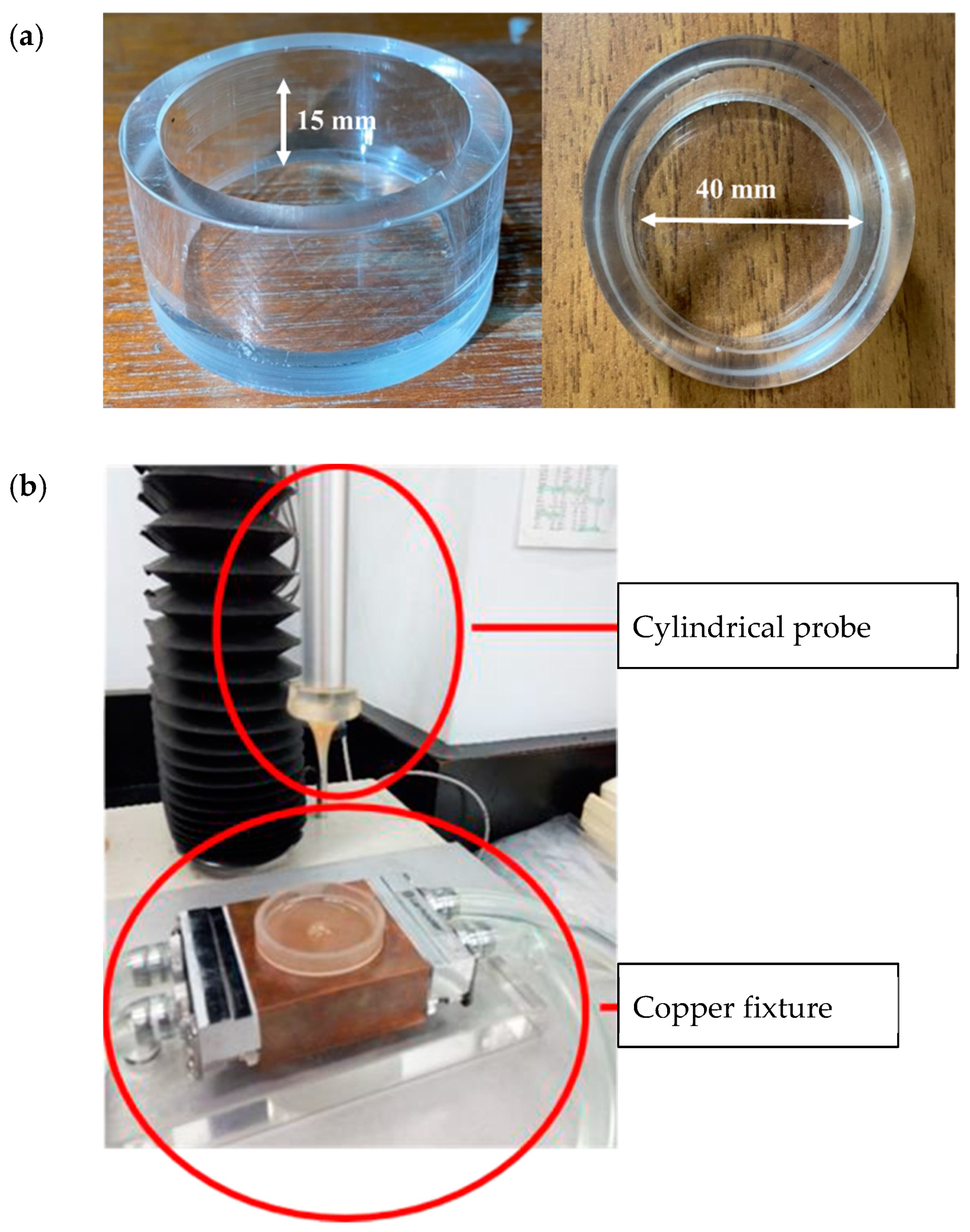
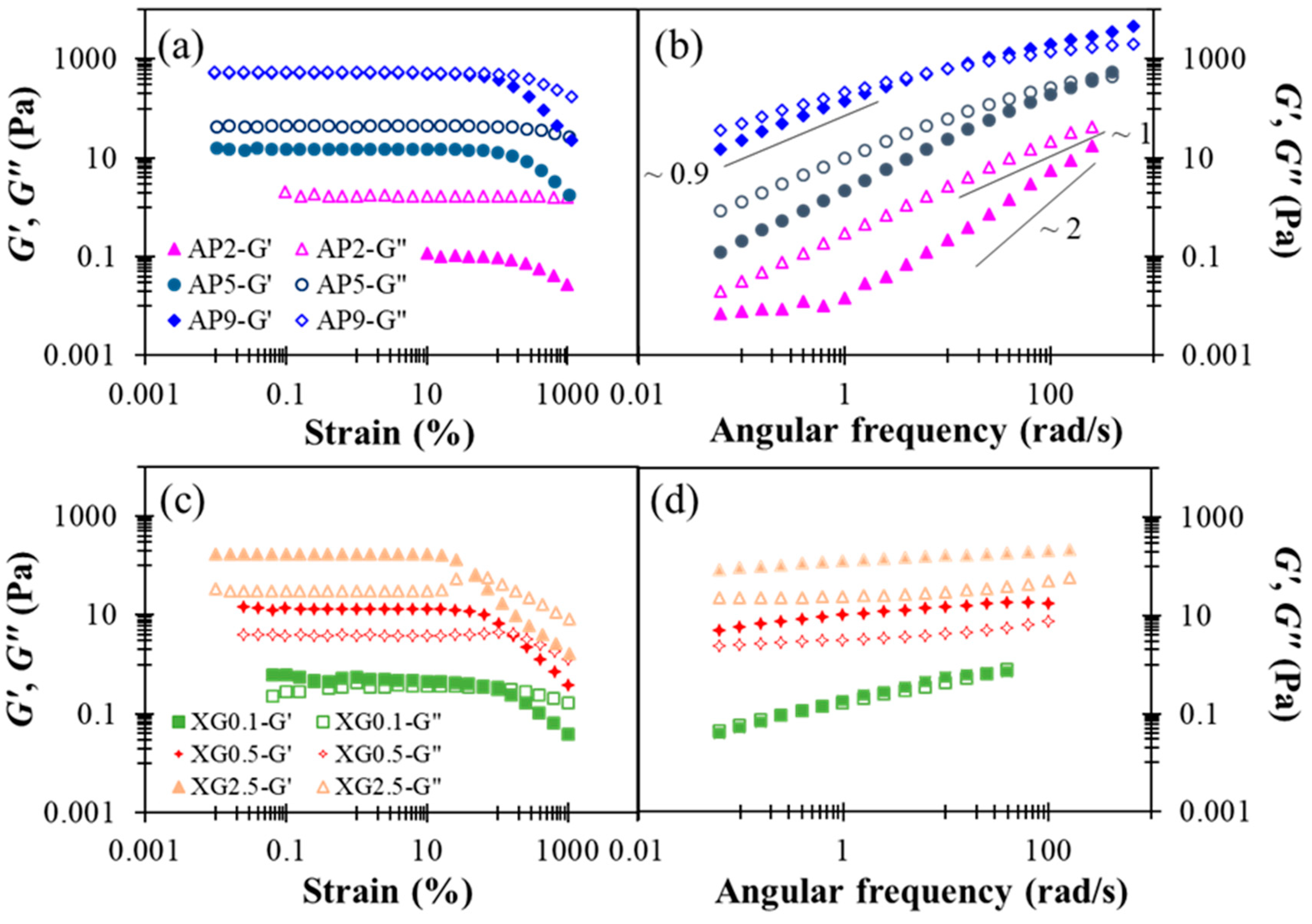
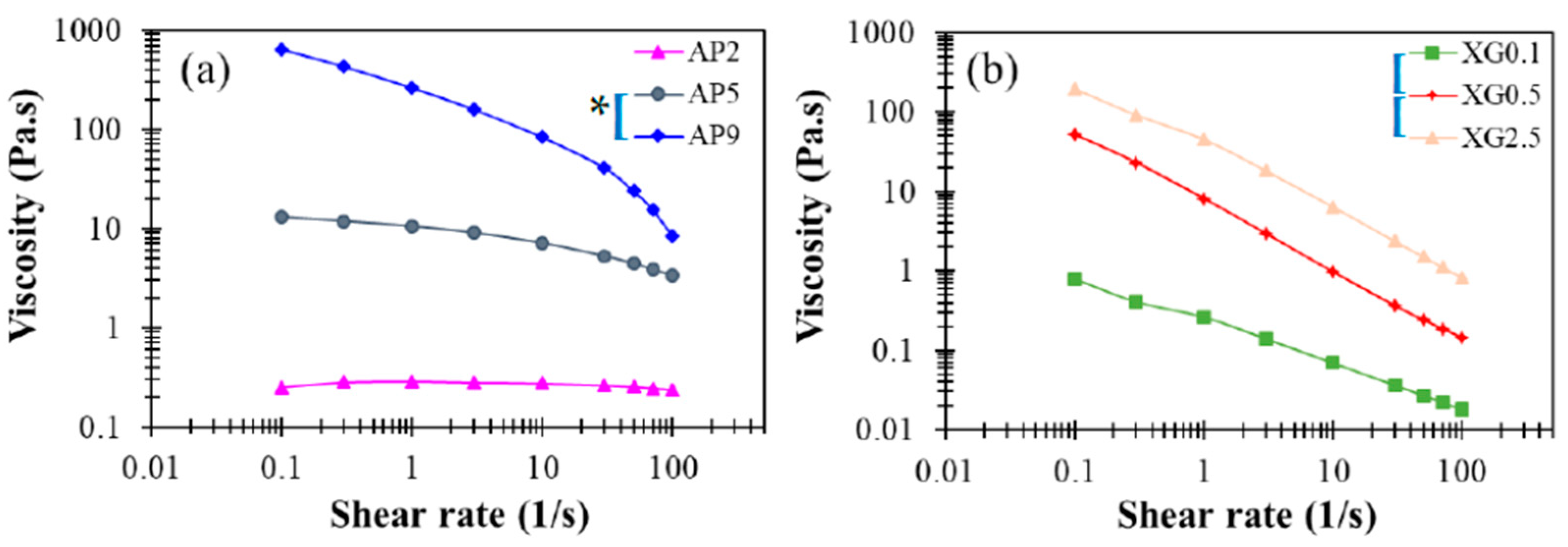

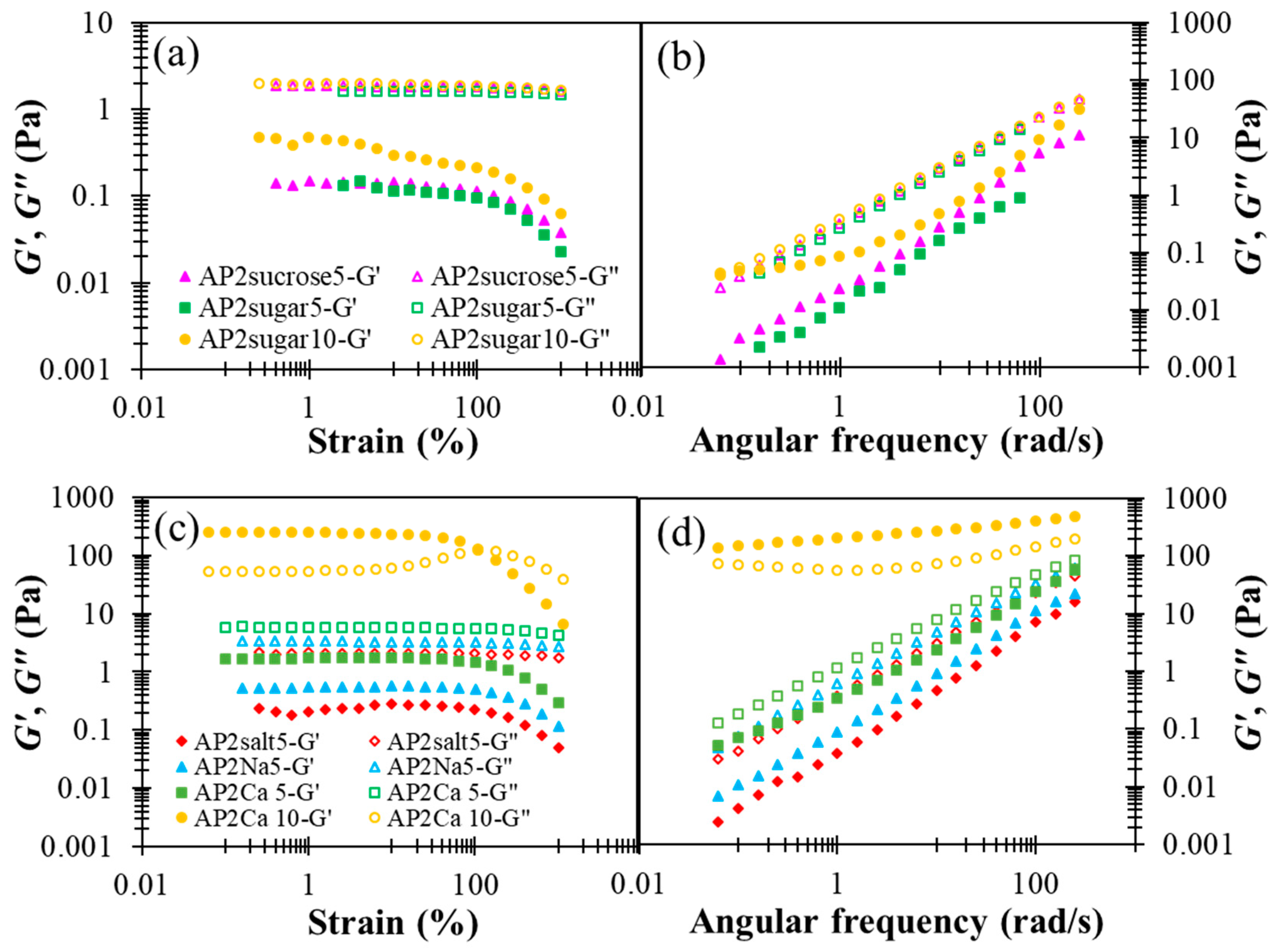
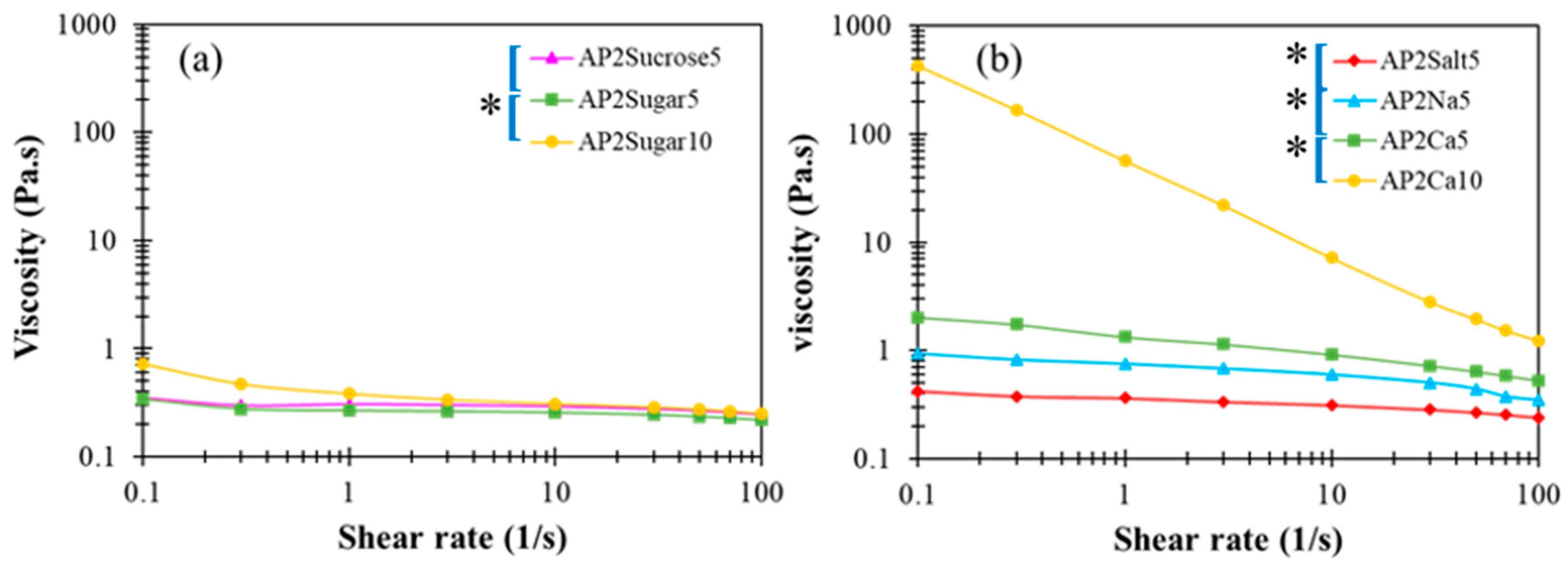




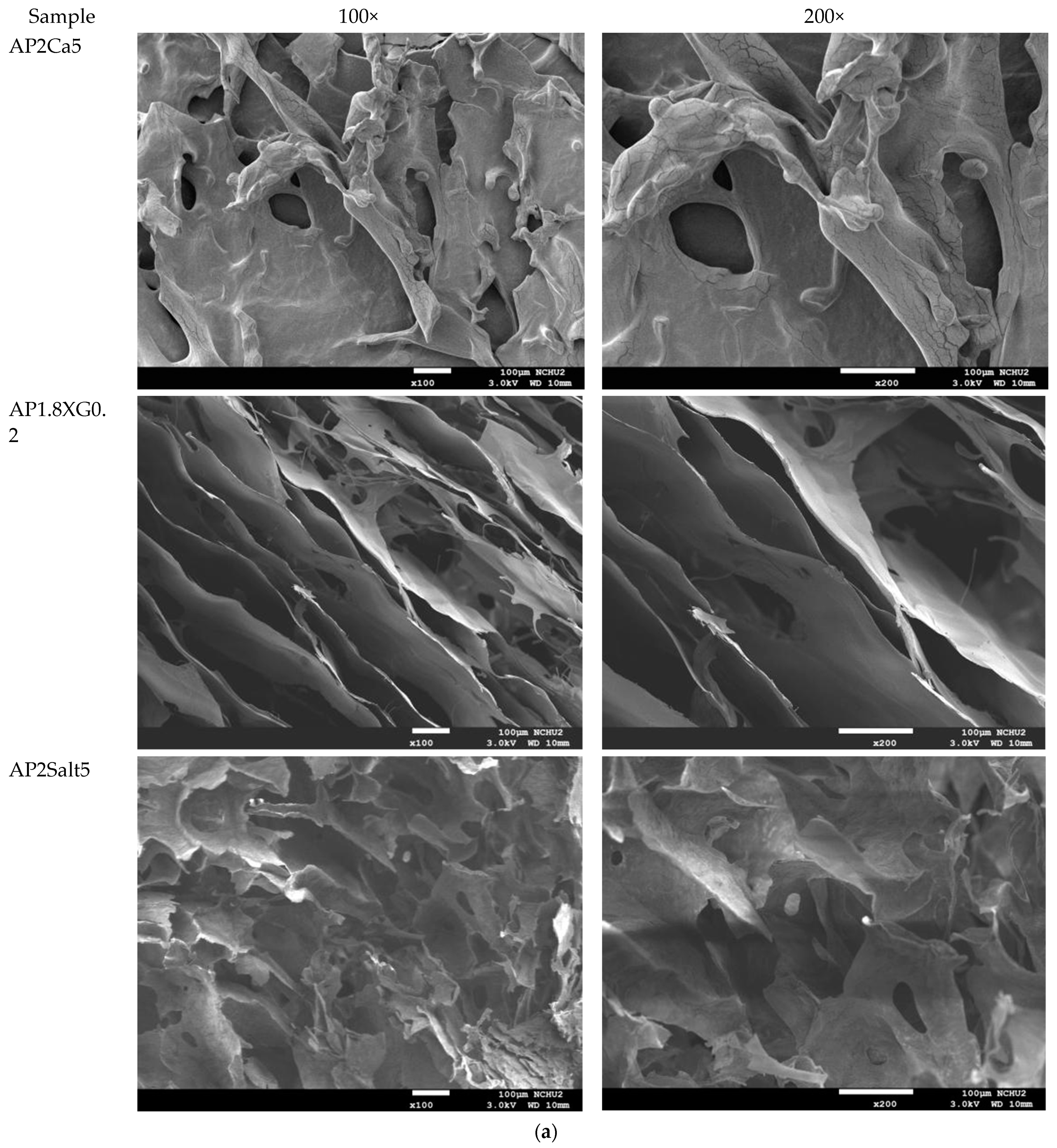

| Thickener | (%, w/w) | BFI | (%, w/w) | Abbreviation |
|---|---|---|---|---|
| Apple pectin (AP) | 2–9 | - | - | AP2-AP9 |
| 2 | Table salt | 5/10 | AP2Salt5 | |
| Sugar granule | AP2Sugar5 | |||
| NaCl | AP2Na5 | |||
| Sucrose | AP2Sucrose5 | |||
| CaCl2 | AP2Ca5/10 | |||
| Xanthan gum (XG) | 0.05–2.5 | - | - | XG0.5-XG2.5 |
| 0.5 | NaCl | 5/10 | XG0.5Na5 | |
| Sucrose | XG0.5Sucrose5 | |||
| CaCl2 | XG0.5Ca5/10 | |||
| Combined AP-XG * | AP1-1.8 + XG1-0.2 | - | - | AP1XG1 through AP1.8XG0.2 |
| Sample | K (Pa·sn) | n | R2 (%) |
|---|---|---|---|
| AP2 | 0.281 ± 0.0029 D,h | 0.974 ± 0.0040 A,abc | 99.96 |
| AP5 | 9.718 ± 0.0712 C,e | 0.802 ± 0.0037 AB,bcd | 99.67 |
| AP9 | 233.574 ± 4.2723 A,a | 0.414 ± 0.0107AB,cde | 92.54 |
| XG0.1 | 0.253 ± 0.0051 D,h | 0.432 ± 0.0012AB,cde | 99.93 |
| XG0.5 | 7.517 ± 0.0890 C,f | 0.128 ± 0.014 B,f | 96.78 |
| XG2.5 | 37.258 ± 0.154 B,c | 0.191 ± 0.0343 B,ef | 93.32 |
| AP2Sugar5 | 0.270 ± 0.0016 C,h | 0.958 ± 0.0035 A,a | 99.99 |
| AP2Sugar10 | 0.532 ± 0.0037 A,h | 0.817 ± 0.0023 B,ab | 99.13 |
| AP2Sucrose5 | 0.316 ± 0.0009 B,h | 0.952 ± 0.0042 A,a | 99.98 |
| AP2Salt5 | 0.348 ± 0.0015 C,h | 0.934 ± 0.0019 A,a | 99.96 |
| AP2Na5 | 0.727 ± 0.0023 C,h | 0.862 ± 0.0024 B,a | 99.84 |
| AP2Ca5 | 1.379 ± 0.0086 B,h | 0.798 ± 0.048 C,ab | 99.97 |
| AP2Ca10 | 64.401 ± 0.5832 A,b | 0.124 ± 0.0089 D,f | 98.11 |
| AP1XG1 | 16.034 ± 0.0472 A,d | 0.318 ± 0.0102 E,def | 99.56 |
| AP1.2XG0.8 | 8.282 ± 0.0374 B,ef | 0.452 ± 0.0086 D,cde | 99.59 |
| AP1.4XG0.6 | 3.791 ± 0.0256 C,g | 0.569 ± 0.0094 C,bcd | 99.63 |
| AP1.6XG0.4 | 1.787 ± 0.0147 D,h | 0.688 ± 0.0024 B,abc | 99.74 |
| AP1.8XG0.2 | 0.903 ± 0.0112 E,h | 0.791 ± 0.0086 A,ab | 99.90 |
Publisher’s Note: MDPI stays neutral with regard to jurisdictional claims in published maps and institutional affiliations. |
© 2021 by the authors. Licensee MDPI, Basel, Switzerland. This article is an open access article distributed under the terms and conditions of the Creative Commons Attribution (CC BY) license (http://creativecommons.org/licenses/by/4.0/).
Share and Cite
Yang, H.; Tsai, C.-C.; Jiang, J.-S.; Hua, C.-C. Rheological and Textural Properties of Apple Pectin-Based Composite Formula with Xanthan Gum Modification for Preparation of Thickened Matrices with Dysphagia-Friendly Potential. Polymers 2021, 13, 873. https://doi.org/10.3390/polym13060873
Yang H, Tsai C-C, Jiang J-S, Hua C-C. Rheological and Textural Properties of Apple Pectin-Based Composite Formula with Xanthan Gum Modification for Preparation of Thickened Matrices with Dysphagia-Friendly Potential. Polymers. 2021; 13(6):873. https://doi.org/10.3390/polym13060873
Chicago/Turabian StyleYang, Huaiwen, Chai-Chun Tsai, Jung-Shiun Jiang, and Chi-Chung Hua. 2021. "Rheological and Textural Properties of Apple Pectin-Based Composite Formula with Xanthan Gum Modification for Preparation of Thickened Matrices with Dysphagia-Friendly Potential" Polymers 13, no. 6: 873. https://doi.org/10.3390/polym13060873
APA StyleYang, H., Tsai, C.-C., Jiang, J.-S., & Hua, C.-C. (2021). Rheological and Textural Properties of Apple Pectin-Based Composite Formula with Xanthan Gum Modification for Preparation of Thickened Matrices with Dysphagia-Friendly Potential. Polymers, 13(6), 873. https://doi.org/10.3390/polym13060873






